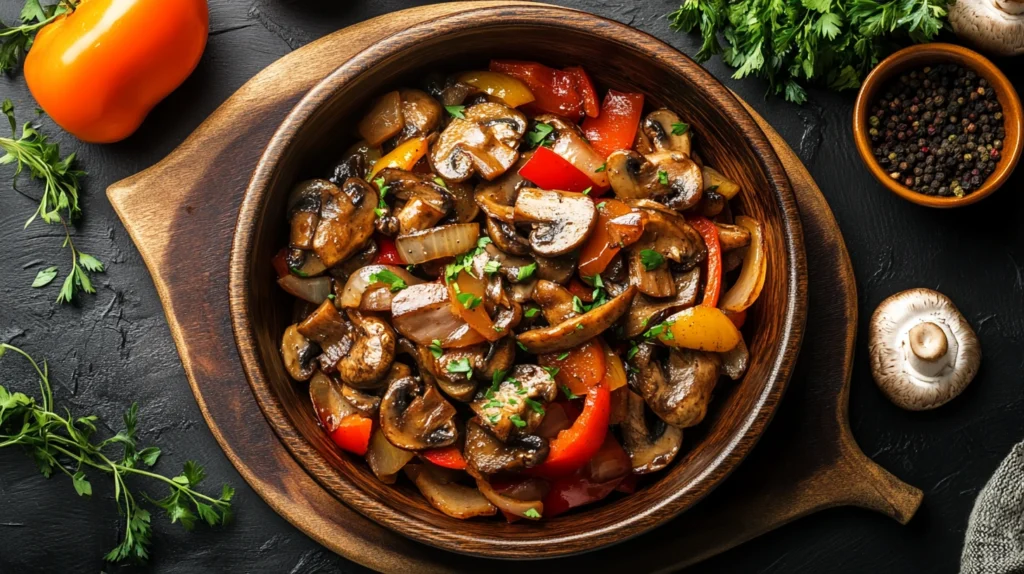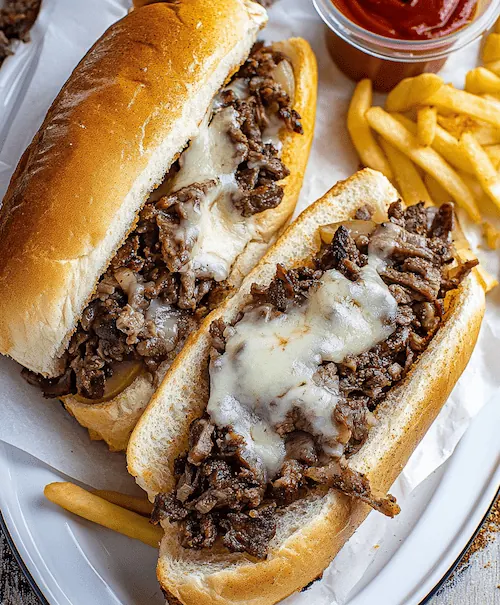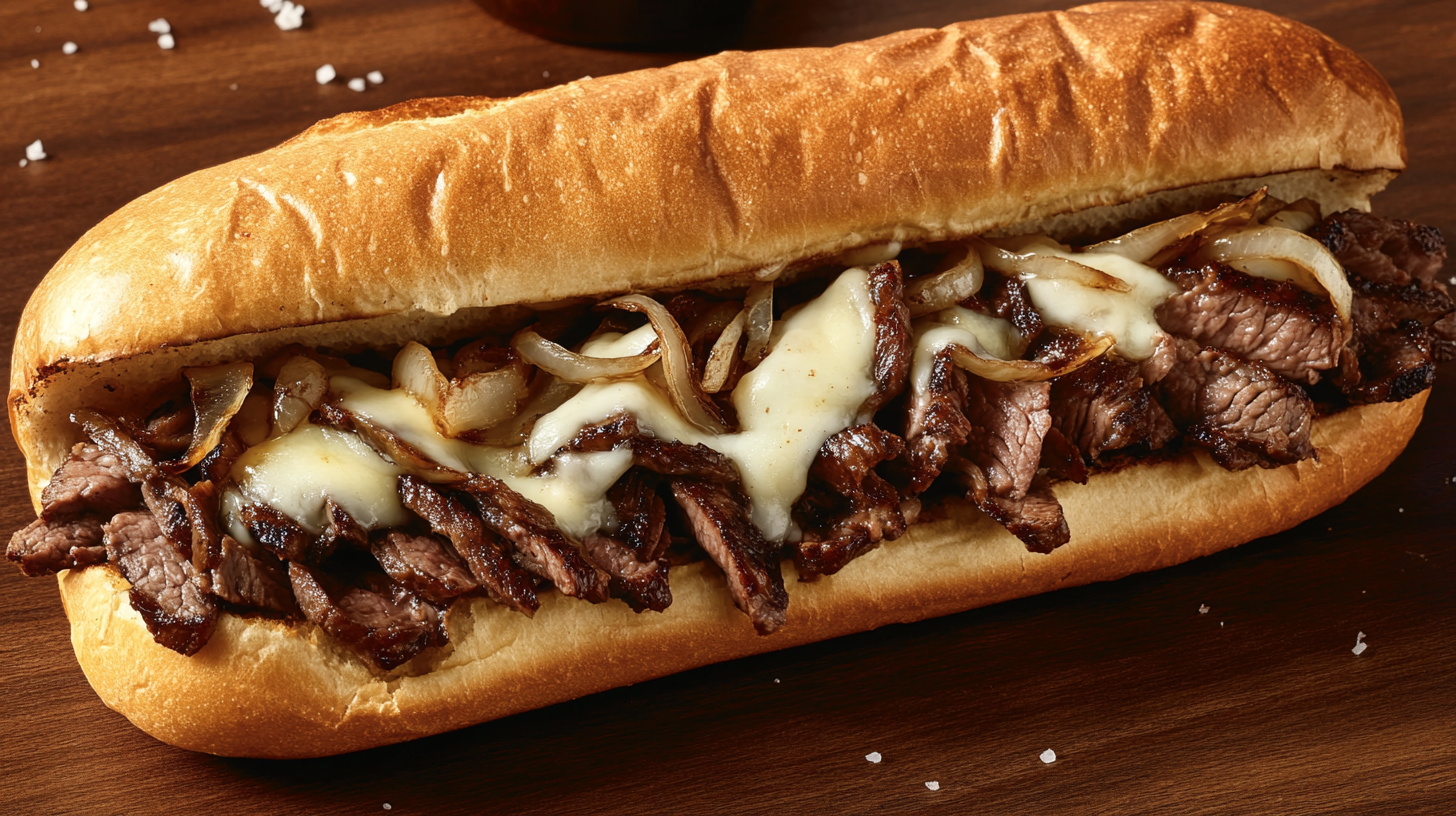Have you ever wondered what seasoning goes on a Philly cheesesteak to make it so delicious? This iconic sandwich combines tender steak, melted cheese, and perfectly seasoned ingredients to create a flavor-packed meal. In this article, we’ll uncover the essential spices, traditional methods, and creative twists that make the Philly cheesesteak a favorite across the country.
Key Ingredients of a Philly Cheesesteak
Before we delve into the specifics of seasoning, let’s identify the core components of a traditional Philly cheesesteak:
- The Meat: Ribeye steak is the classic choice for its tenderness and flavor.
- The Cheese: Provolone, American cheese, or Cheez Whiz is typically used.
- The Bread: A long hoagie roll forms the foundation.
- The Vegetables: Sautéed onions, and optionally, bell peppers or mushrooms.
The Role of Seasoning in a Cheesesteak
Seasoning enhances the natural flavors of these ingredients, ensuring every bite is savory and satisfying. Whether you’re sticking to traditional seasoning or experimenting with modern twists, the right blend of spices can transform your sandwich from good to unforgettable.
Traditional Philly Cheesesteak Seasonings
While a Philly cheesesteak doesn’t rely on overly complex spices, the simplicity of its traditional seasoning is what makes it so flavorful. Here are the key seasonings commonly used:
Salt and Black Pepper
These two staples form the backbone of a Philly cheesesteak’s flavor profile. Salt brings out the natural taste of the ribeye steak, ensuring every bite is flavorful. Meanwhile, black pepper provides a subtle kick and a hint of complexity. When combined, they enhance the savory quality of the meat without overpowering its richness.
Garlic Powder
A sprinkle of garlic powder adds a subtle, savory note to the steak, complementing its rich flavors. It’s a common addition that elevates the sandwich without straying from tradition.
Onion Powder
Onion powder pairs perfectly with the sautéed onions often included in a Philly cheesesteak. Its mild sweetness and umami bring balance to the overall flavor.
Optional Seasonings for Extra Flavor
For those who like to experiment, adding optional seasonings can provide a personalized touch without sacrificing authenticity.
Smoked Paprika
A dash of smoked paprika can introduce a hint of smokiness to the meat, enhancing its savory depth.
Chili Flakes
If you prefer a little heat, chili flakes are an excellent choice. They add just enough spice to give the sandwich a bolder kick.
Worcestershire Sauce
While not a spice, a splash of Worcestershire sauce can enhance the meat’s umami flavor and provide a tangy undertone. Use it sparingly to avoid overpowering the other ingredients.
Understanding the Role of Meat in Seasoning
The choice of meat plays a huge role in how seasonings enhance a Philly cheesesteak. Ribeye steak, known for its rich flavor, is the go-to choice for this classic dish.
Ribeye Steak: Why It’s the Best Option
Known for its tenderness and rich flavor, ribeye steak is the top choice for a Philly cheesesteak. The marbling in this cut melts during cooking, infusing the meat with juiciness and a deep, savory taste. Additionally, its natural flavors blend seamlessly with simple seasonings like salt and pepper, allowing the beef’s bold profile to stand out.
Tips for Properly Seasoning the Meat
Seasoning your meat the right way can make or break your cheesesteak. Here’s how you can get it just right:
- When to Add Seasoning: Sprinkle the seasonings just before cooking. This allows the flavors to stick to the meat and keeps it juicy. Adding spices too early can dry out the steak, which you definitely don’t want.
- How Much to Use: Start small! A light dash of each spice is enough to enhance the flavor. If you’re unsure, you can always add more later.
- Cooking Method: Using a hot skillet or griddle is a must. High heat sears the steak beautifully, locking in the juices and giving the seasonings a delicious, crispy crust.
With these tips, your meat will be perfectly seasoned every time, making your Philly cheesesteak the star of the meal.
Vegetables and Their Seasoning
While the meat and cheese are the stars of a Philly cheesesteak, the vegetables play a crucial supporting role. Sautéed onions, bell peppers, and mushrooms are the most common additions, and they can be seasoned to complement the dish.

Sautéed Onions
Onions are a must in most Philly cheesesteaks, adding sweetness and texture. When cooked, they caramelize, creating a rich flavor that balances the savory steak.
- Seasoning Tip: Sprinkle a pinch of salt and a light dash of garlic powder while sautéing to enhance their natural sweetness. Stir frequently to prevent burning and to achieve a golden-brown color.
Bell Peppers and Mushrooms
Although not traditional, many people enjoy the extra flavor and texture that bell peppers and mushrooms bring to the sandwich.
- Seasoning for Bell Peppers: A touch of black pepper and a small sprinkle of smoked paprika can add depth to the peppers’ natural sweetness. Slice them thinly for even cooking.
- Seasoning for Mushrooms: Mushrooms absorb seasonings well. A pinch of salt and a splash of Worcestershire sauce while cooking enhances their earthy flavor.
Enhancing Vegetables with Spices
If you want to take your veggies to the next level, try these quick tips:
- Use a mix of olive oil and butter for sautéing. The butter adds richness, while the oil prevents burning.
- Add seasonings gradually. This lets you adjust the flavor as you cook.
- Don’t overcrowd the pan. Give the veggies space to cook evenly and develop their best flavor.
By giving attention to the vegetables and their seasonings, you’ll add layers of flavor and create a cheesesteak that feels complete.
Choosing the Right Cheese for Flavor Balance
Cheese is the final layer of flavor that brings everything together in a Philly cheesesteak. While traditional options like provolone, American cheese, or Cheez Whiz dominate, choosing the right cheese and pairing it with the seasoning is key to crafting a perfect sandwich.
Common Cheese Choices
Each type of cheese adds its own unique flavor to the sandwich. Here’s a closer look:
- Provolone: A slightly sharp and tangy cheese, provolone is a classic choice for its balanced flavor that complements the seasoned steak.
- American Cheese: Known for its creamy and mild taste, American cheese melts beautifully, enveloping the meat and vegetables in a silky layer.
- Cheez Whiz: For a more indulgent option, Cheez Whiz offers a bold, salty, and gooey texture that Philadelphia locals often swear by.
How Cheese Complements the Seasoning
The cheese you choose should enhance, not overpower, the seasoning on the meat and vegetables. For example:
- Provolone pairs well with the simplicity of salt, pepper, and garlic powder.
- American cheese works beautifully with vegetables that have been seasoned with smoked paprika or Worcestershire sauce.
- Cheez Whiz provides a bold contrast to the meat’s savory seasoning, amplifying the overall flavor profile.
Tips for Melting the Cheese
To get the perfect cheesy texture, here’s what you can do:
- Add the cheese directly to the hot skillet over the cooked meat and vegetables.
- Cover the skillet with a lid for a minute or two to trap heat, allowing the cheese to melt evenly.
- Layer the melted cheese mixture onto your hoagie roll for a gooey and satisfying bite.
The right cheese, combined with well-seasoned meat and vegetables, ensures a perfect harmony of flavors in every bite.
Bread and Its Impact on Flavor
The bread is the foundation of a Philly cheesesteak, holding everything together while adding texture and flavor. Choosing the right bread and seasoning it properly can elevate the sandwich to a whole new level.
Ideal Bread for a Cheesesteak
Traditionally, a soft hoagie roll is used for Philly cheesesteaks. The bread needs to be sturdy enough to hold the meat, cheese, and vegetables without falling apart, yet soft enough to soak up the juices.
- Classic Hoagie Rolls: Slightly crusty on the outside and fluffy on the inside, they provide the perfect balance.
- Alternative Options: For a twist, some people use ciabatta, French bread, or even brioche buns.
Seasoning Considerations for the Bread
Although the bread doesn’t require heavy seasoning, adding a subtle flavor can enhance the sandwich. Here’s how:
- Toasting the Bread: Spread a thin layer of butter or garlic spread on the inside of the roll before lightly toasting it on a skillet. This step adds a touch of richness and a slight crunch.
- Herb Butter: Mixing herbs like parsley or a hint of oregano into the butter can add an aromatic layer to your bread.
- Optional Sauces: For those who enjoy more flavor, consider spreading a thin layer of mayo, spicy aioli, or even a drizzle of Worcestershire sauce for a tangy kick.
Making Sure the Bread Holds Up
To avoid soggy bread, follow these quick tips:
- Toast the inside lightly to create a barrier for the juices.
- Assemble the sandwich just before serving to prevent the bread from sitting too long with wet ingredients.
- Choose high-quality rolls that won’t crumble under the weight of the filling.
When the bread is prepared correctly, it complements the seasoned meat, cheese, and vegetables, making every bite of your Philly cheesesteak satisfying and complete.
Regional Variations in Cheesesteak Seasoning
While the original Philly cheesesteak recipe remains iconic, regional variations and modern twists have introduced new flavors to this beloved sandwich. These variations often reflect local tastes, preferences, and creativity.
Philadelphia-Style Cheesesteak
The classic Philadelphia-style cheesesteak sticks to simple seasonings—salt, pepper, garlic powder, and onion powder. It focuses on highlighting the natural flavors of the ribeye steak, sautéed onions, and cheese. Purists insist on keeping it straightforward to preserve the authentic Philly experience.
Modern Twists on Seasoning
As the cheesesteak spread across the country, chefs and home cooks began experimenting with new flavors. Here are some popular modern seasoning twists:
- Herbs: Fresh herbs like rosemary, thyme, or parsley add an earthy flavor and a touch of sophistication to the sandwich.
- Spices: Smoked paprika, cayenne pepper, or cumin can introduce warmth and depth, catering to those who enjoy bolder flavors.
- Fusion Influences: Some variations incorporate global spices, such as soy sauce for an umami boost or curry powder for a unique, spicy twist.
Creative Seasoning Variations Across Regions
Different regions have put their own spin on the cheesesteak, often using local ingredients:
- West Coast Cheesesteak: Adds avocado slices and sometimes chipotle seasoning for a smoky, creamy flavor.
- Southern Cheesesteak: May include barbecue sauce and a sprinkle of Cajun seasoning to give it a zesty kick.
- New York-Style Cheesesteak: Often features sharper cheese varieties like cheddar or Swiss, paired with stronger seasonings like red pepper flakes.
Balancing Tradition with Creativity
When trying a new seasoning variation, it’s important to keep the balance right. Overpowering the natural flavors of the steak and cheese can stray too far from what makes a Philly cheesesteak special. The best innovations enhance, rather than replace, the core elements of the sandwich.
Exploring Variations
If you’re interested in exploring different takes, check out this irresistible chicken Philly cheesesteak recipe. It’s a lighter alternative that doesn’t skimp on flavor.
Tips for Perfect Seasoning
- Season the meat before cooking to lock in flavor.
- Use fresh spices for the most vibrant taste.
- Experiment with spice blends like Cajun or Montreal steak seasoning for a unique twist.
Common Mistakes to Avoid When Seasoning
Even though making a Philly cheesesteak seems simple, certain seasoning mistakes can easily throw off the flavor balance. Knowing what to avoid can help you create a sandwich that’s delicious every time.
Overseasoning
One of the most common pitfalls is using too much seasoning. While it might seem like more is better, overloading the steak or vegetables with spices can mask their natural flavors.
- Solution: Stick to a light hand with salt, pepper, and other seasonings. Taste as you go and adjust gradually.
Underseasoning
On the flip side, underseasoning can make the sandwich bland and unmemorable. Since ribeye steak has a naturally rich flavor, it benefits from a little boost to bring out its best qualities.
- Solution: Season the steak evenly before cooking, and don’t forget to add a pinch of seasoning to your vegetables for balance.
Using the Wrong Spices
Certain spices, while great in other dishes, may not work well in a cheesesteak. Overpowering flavors like cinnamon or nutmeg can clash with the savory profile of the sandwich.
- Solution: Stick to traditional seasonings like garlic powder, onion powder, salt, and pepper. Experiment with bolder spices sparingly to ensure they complement the sandwich.
Ignoring the Timing of Seasoning
When you season can make a huge difference in the final flavor. Adding seasoning at the wrong time might result in unevenly flavored meat or soggy bread.
- Solution: Always season the steak just before cooking for even distribution. Avoid seasoning the bread until right before assembly to keep it crisp.
Overcomplicating the Recipe
Trying to add too many seasonings or ingredients can detract from the simple, iconic nature of a Philly cheesesteak.
- Solution: Focus on the essentials—quality meat, cheese, and bread, with a handful of well-balanced seasonings. Simplicity often leads to the best results.
By avoiding these common mistakes, you’ll ensure your Philly cheesesteak is consistently flavorful and satisfying.
Quick Homemade Philly Cheesesteak Seasoning Mix
If you want a foolproof way to season your Philly cheesesteak, making your own seasoning mix is a great option. A well-balanced mix ensures consistent flavor and saves time during preparation. Here’s a simple recipe to get you started.

Simple Recipe for a Balanced Seasoning Mix
Ingredients:
- 1 tablespoon of salt
- 1 tablespoon of black pepper
- 1 teaspoon of garlic powder
- 1 teaspoon of onion powder
- 1/2 teaspoon of smoked paprika (optional)
- 1/4 teaspoon of chili flakes (optional, for a slight kick)
Directions:
- Combine all the ingredients in a small bowl and mix well.
- Store the seasoning mix in an airtight container. It will stay fresh for up to three months.
- When ready to use, sprinkle the mix lightly over your ribeye steak, vegetables, or even the bread for added flavor.
How to Use the Seasoning Mix
- For the Meat: Rub the mix onto the steak just before cooking. Use about a teaspoon per portion to keep the flavor balanced.
- For Vegetables: Add a small pinch to your sautéed onions, peppers, or mushrooms while they cook.
- For the Bread: Lightly sprinkle the seasoning mix onto buttered bread before toasting for a subtle flavor boost.
Why Make Your Own Mix?
Homemade seasoning mixes let you control the flavor and adjust the proportions to your liking. You can make it spicier by adding more chili flakes or tone it down for a more traditional taste.
Frequently Asked Questions
Can I Use Pre-Made Seasoning Blends?
Yes, you can! Many store-bought steak or all-purpose seasoning blends work well for Philly cheesesteaks. However, be cautious with blends that include overpowering ingredients like cumin or sugar, as they may alter the traditional flavor profile.
What Seasoning Works Best for a Healthier Version?
For a lighter version, use minimal salt and opt for fresh herbs like parsley or thyme. You can also add a splash of lemon juice for a natural, zesty flavor without adding extra calories or sodium.
Can I Make a Vegetarian Philly Cheesesteak?
Absolutely! Swap the ribeye steak for portobello mushrooms or seitan. Season these substitutes with the same mix of salt, pepper, garlic powder, and onion powder for a similar savory flavor.
How Can I Add a Spicy Kick to My Cheesesteak?
For a spicier version, add chili flakes, cayenne pepper, or even a dash of hot sauce to your steak or vegetables. Be sure to add spice gradually to avoid overpowering the other flavors.
Should I Season the Cheese?
Typically, the cheese doesn’t need seasoning, as it provides its own distinct flavor. However, if you’re using a mild cheese like mozzarella, a pinch of garlic powder or paprika can enhance its taste.
What’s the Best Way to Avoid Soggy Bread?
To prevent soggy bread, lightly toast the hoagie roll and add a layer of melted cheese or butter before assembling the sandwich. This creates a barrier that helps the bread hold up against the juicy steak and vegetables.
Conclusion
Seasoning is the key to a perfect Philly cheesesteak, elevating the sandwich from simple to extraordinary. Whether you stick to the traditional blend of salt, pepper, garlic, and onion powder, or experiment with modern twists like smoked paprika or chili flakes, the right flavors will transform your meal. By paying attention to the meat, vegetables, cheese, and even the bread, you can create a cheesesteak that’s bursting with balanced, delicious flavor in every bite.
Seasoning is a small but vital step in crafting a Philly cheesesteak that stands out. Whether you keep it traditional or venture into bold flavors, make sure to let the seasoning shine without overpowering the star ingredients. And don’t forget to explore complementary recipes like what can I add to baked beans for flavor? to complete your meal.

